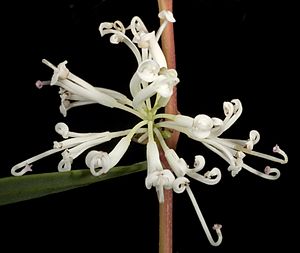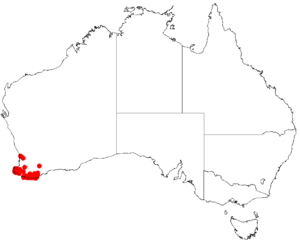Hakea linearis facts for kids
Quick facts for kids Hakea linearis |
|
|---|---|
 |
|
| Scientific classification | |
| Genus: |
Hakea
|
| Species: |
linearis
|
 |
|
| Occurrence data from AVH | |
Hakea linearis is a type of shrub or small tree. It belongs to the Proteacea family of plants. This plant is special because it only grows in Western Australia. It has smooth branches, long, thin leaves, and pretty white flowers.
What is Hakea linearis Like?
This shrub or tree usually grows between 0.6 to 4 metres (2 to 13 ft) tall. Its branches are very smooth, without any hairs. The leaves are also smooth and stay green all year. They are long and thin, like a line, or slightly oval. These leaves are typically 2 to 8 centimetres (0.8 to 3.1 in) long and 2 to 7 millimetres (0.079 to 0.276 in) wide.
Hakea linearis blooms for many months of the year. You can see its cream-white flowers from January to May, or from October to December. Each flower cluster has about 16 to 20 small flowers. These flowers have a smooth, white outer part that is 3 to 5 mm (0.118 to 0.197 in) long.
After the flowers, the plant grows interesting fruits. They are shaped like an upside-down egg, but a bit slanted. They have a curved tip and look bumpy or black-spotted. Each fruit is about 1.5 to 2.5 cm (0.59 to 0.98 in) long and 0.7 to 1 mm (0.028 to 0.039 in) wide. They also have small "horns" that are 2 to 4 mm (0.079 to 0.157 in) long. Inside, the seeds are also egg-shaped and have a wing on one side.
Naming and Discovery
The first official description of Hakea linearis was made in 1810. A botanist named Robert Brown wrote about it. His description was published in a scientific journal called Transactions of the Linnean Society of London.
The plant's scientific name, linearis, comes from a Latin word. It means "linear" or "like a line." This name refers to the long, thin shape of its leaves. Sometimes, people might confuse Hakea linearis with another plant called Hakea varia or similar species.
Where Does It Grow?
Hakea linearis is a plant that is endemic to a specific part of Western Australia. This means it naturally grows only in this area and nowhere else in the world. You can find it along the coast in the South West and Great Southern regions. This area stretches from Busselton in the west to Wagin in the north, and down to Albany in the south.
This plant often grows near granite rocks. It also likes areas that get wet during certain seasons, like swamps. You can usually find it in sandy or sandy-clay soils. It is a common plant in sandy heathlands or in woodlands where Eucalyptus trees grow.

